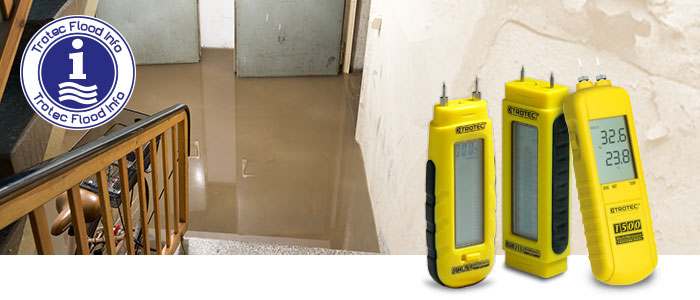
When the cellar is completely under water it is clear that it has to be dried. But what about the floors above? Can the moisture rise via the capillaries? Is the floor construction soaked? Particularly important is the question when the dehumidification will be over and when you don’t have to expect any consequential damages. Another important fact for you to know is to what extent you can make the dehumidification on your own and when it is necessary to ask an expert.
To answer these and other question you have to measure the moisture in the affected areas. Electronic moisture meters are very reliable and you can distinguish between two measuring principles:
- Measurement devices using the resistance principle
- Dielectric measurement devices
Resistance measuring devices use two electrodes leading current through the building structure to be measured. When the structure is dry the resistance is very high because dry materials conduct current only poorly. The more moisture is in the building structure the more the conductivity rises because water conducts the current pretty well. With this measuring method you can measure the moisture content on the material surface as well as in deeper building component layers to check if a wall is only dry on the surface or, as well, deeper inside the wall.
The dielectric measurement method uses another principle. With an electrical stray field you use a mostly spherical sensor for a non-destructive measurement that reaches a few centimetres into the building structure.
What mistakes can happen and when should I ask an expert?
Some factors can falsify the results of both measuring methods. In the building structure contained salt, for instance, can increase the measured value. In such a situation you have to ask an expert.
Using the resistance measurement you have to be careful not to measure other conductive materials like cables, water pipes etc. because they distort the results
How do I interpret the measured values?
The measuring devices from the Multi Measure Series, the T510 moisture meter for example, show you the results in so called digits. Values under 30 digits say that the building structure is dry. Values over 70 digits mean a strong moisture penetration. Between 30 and 70 digits it is necessary to make an individual decision according to the characteristics of the damage.
Our moisture meters BM15 and BM20 use the resistance principle as well. They just don’t show the results in digits but in per cent by volume.
Using dielectric measuring devices we have to distinguish between two devices for the evaluation of the measured values. Over 50 digits the BM30 moisture indicator indicates a soaked building structure.
The T650 shows that a building structure is soaked when the value is over 80 digits.
Which device is right for me?
The dielectric measuring instruments have the advantage that they measure non-destructive up to depths of four centimetres by just putting the spherical sensor on the material surface. Using the resistance principle you have to press the electrodes into the material but with that method you can measure deeper that four centimetres.
When your dehumidification is over the measured values should lie clearly under the values mentioned here. Then really everything is dry and you don’t have to be afraid of consequential damages.
Trotec Flood Info: To inform you in any case of damage
We inform you about the following topics in detail:
- Trotec assists flood victims with expertise
- How long does a dehumidification take?
- Should I rent or buy a drying unit?
- Trotec Flood Info: The right moisture measurement after flood damages
- Trotec Flood Info: When do I need an expert?
- Trotec Flood Info: What to do when mould attacks?
- Trotec Flood Info: How to dry floor insulations
- Trotec Flood Info: What to do against the smell after the flood damage?
- Trotec Flood Info: The main facts about drying units

